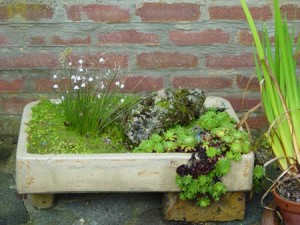





One of the great attractions of rock-garden plants is their gem-like quality; often large flowers borne on disproportionately small growth. Full enjoyment is a hands-and-knees job, especially if they are scented. This is why many specialists prefer to grow their plants in pots in cold frames and bring them into an unheated ‘alpine house’ for the flowering period. A good alternative is to raise the rock bed by about 60 cm (2 ft). Maintenance is made easier, further plants can grow in spaces left in the supporting walls and the whole concept is brought nearer to the eyes and nose. A raised bed of this type can happily surround a sitting out area or an edge of a patio.
In the more formal setting of a terrace it is desirable that construction of such a raised bed should repeat something of this feeling. If possible, and especially if one end abuts an existing wall, the material used should be the same as the adjoining building. This does help to give a feeling of continuity by linking the house with the garden.
Often in such a position the raised bed is nothing more than a double wall filled with soil. This seems to be a sadly wasted opportunity as such a position is perfect for so many lovely plants. Why be so mean about it? A width of 1m (3ft) would seem a sensible minimum for all but the smallest plots. However, many people would prefer to use such a position for the bigger, brighter flowers provided by seasonal bedding. Remember though, that wallflowers and tulips planted in November have got five months (almost half a year) of absolute dullness before they do anything. And maddeningly they are still in flower when you pull them out to make room for the summer plants. Better, perhaps, is to concentrate seasonal flowers in a number of containers and move them about for the best effect as they come into their own.
Often a small garden really has no space for a rock garden or any usual alternative, yet still these little rock plants are coveted. Two possibilities emerge. One is to grow the dwarfest plants in a miniature rock landscape made in a sink. The other is to make literally a rock garden; that is a garden in a single piece of rock.
The second idea is one that is catching on fast, though there must be a limit to the amount of rock available. The type of rock used is tufa, a relatively light-weight porous form of limestone which can hold sufficient moisture for plant growth without permitting lush growth.
A block of tufa weighing about 50 kg (1 cwt) will measure an irregular 45 cm by 45 cm by 30cm (18in by 18in by 12in). Holes are chipped out (an electric drill with a masonry bit is ideal for the job) in a downwards sloping direction, an inch or two wide and twice that in depth. Really young alpines, brought from a specialist nursery, are then planted carefully in a compost made up of half coarse sand and half leafmould with some tufa chippings added.
The block should be protected from drying winds if possible, and stand on soil so that it can absorb moisture. Rain is seldom sufficient and indeed watering from above will be necessary initially. If the tufa garden is to be in a courtyard it should stand on a tray of sand which must be kept moist. Tufa gardens are a relatively easy way of growing high alpine cushion or rosette plants that most people find impossible in normal conditions.
 These are less specialist but because of their small size, similar individual attention is possible. Few people can now find (or afford) the lovely old natural-stone sinks that used to be a feature of farmyards. But the deep glazed sinks — so often thrown away when a house is being modernised — can be nearly as good. The depth is right and the shiny white glaze can be perfectly disguised by making a mixture of 2 parts coarse sand to 1 part of peat to 1 part cement (by volume) with water. Then apply this to the outside of the sink.
These are less specialist but because of their small size, similar individual attention is possible. Few people can now find (or afford) the lovely old natural-stone sinks that used to be a feature of farmyards. But the deep glazed sinks — so often thrown away when a house is being modernised — can be nearly as good. The depth is right and the shiny white glaze can be perfectly disguised by making a mixture of 2 parts coarse sand to 1 part of peat to 1 part cement (by volume) with water. Then apply this to the outside of the sink.
The end result is a container of perhaps 1 sq m (3 sq ft) which can hold an upright conifer such as Juniperus communis compressa or a tiny pencil-like cypress is ideal, a small spreading shrublet or two, some dwarf bulbs and a few rosette plants. It can provide interest throughout the year. One immediate advantage is that ideal soil can be given to plants such as autumn gentians, otherwise impossible to grow when the garden soil is limy.
Copyright © www.100flowers.win Botanic Garden All Rights Reserved